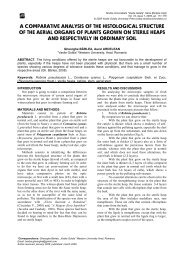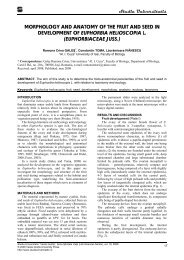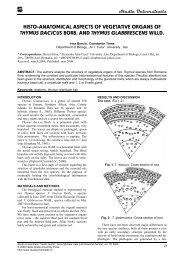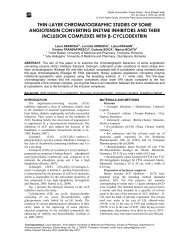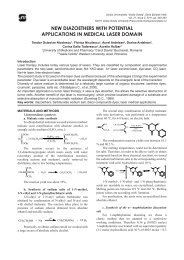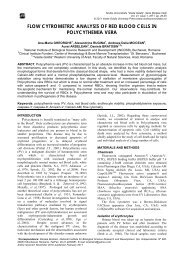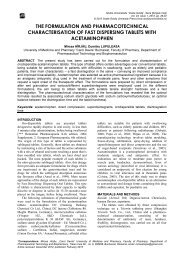Lacrajnan - Varghese - Studia Universitatis Vasile Goldis, Seria ...
Lacrajnan - Varghese - Studia Universitatis Vasile Goldis, Seria ...
Lacrajnan - Varghese - Studia Universitatis Vasile Goldis, Seria ...
You also want an ePaper? Increase the reach of your titles
YUMPU automatically turns print PDFs into web optimized ePapers that Google loves.
Integration of artificial neural networks<br />
into an lindenmayer system based plant<br />
modeling environment with mathematica<br />
longitudinal, lateral, and vertical axes is rl (roll left), rr<br />
(roll right), pu (pitch up), pd (pitch down), yl (yaw left)<br />
and yr (yaw right) in Table 1, thus translating a one-<br />
dimensional string into a 3D geometrical object<br />
resembling a plant (some of these commands do not occur<br />
in the example L-system).<br />
The D0L-System encodes turtle geometry macros for<br />
generating graphical representations of the leaves,<br />
blooms and stalks. An each symbol, f represent<br />
commands to move forward the turtle, b represent<br />
commands to move backward the turtle and change the<br />
drawing tools orientation by rotation around its<br />
Symbol<br />
of<br />
string<br />
FO[s]<br />
PU(α)<br />
PD(α)<br />
RR(α)<br />
RL(α)<br />
YR(α)<br />
YL(α)<br />
Turtle Rules for Interpreting 3D<br />
Description<br />
Advances the turtle by a step size of s<br />
in the direction and draws a line<br />
depending on the current color and line<br />
thickness settings.<br />
The turtle is tilted up around its<br />
transverse axis y by an angle of α<br />
degree.<br />
The turtle is tilted down around its<br />
transverse axis y by an angle of α<br />
degree.<br />
The turtle is rotated right (clockwise)<br />
around its longitudinal axis x by an<br />
angle of α degrees.<br />
The turtle is rotated left (clockwise)<br />
around its longitudinal axis x by an<br />
angle of α degrees.<br />
The turtle is rotated right (clockwise)<br />
around its vertical axis Z by an angle of<br />
α degree.<br />
The turtle is rotated left<br />
(counterclockwise) around its vertical<br />
axis Z by an angle of α degree.<br />
Table 1<br />
The kLSystems package in MathEvolvica (Jacob,<br />
1995) contains definitions for the application of parallel<br />
rewrite rules of L-Systems with left and right contexts<br />
with arbitrary length. Each rule of the form l < p > r → s as<br />
described above is represented by a Mathematica<br />
expression of the form<br />
LRule[ LEFT[ l ], PRED[ p ], RIGHT[ r ], SUCC[ s ] ].<br />
Accordingly, we define the production set as an<br />
LRULES expression<br />
LRULES [ LRule[...], LRule[...], ... ]<br />
and an L-system is described as follows:<br />
LSystem[ _AXIOM, LRULES[ __LRule] ]<br />
With this representation we can easily derive the type<br />
of the expressions and sub expressions by only looking at<br />
sprout symbols. Application kLSystems package in<br />
MathEvolvica at plant growth of Zinnia Elegane Jacq<br />
(Lydia, 1998).<br />
<strong>Studia</strong> <strong>Universitatis</strong> “<strong>Vasile</strong> Goldiş”, <strong>Seria</strong> Ştiinţele Vieţii<br />
Vol. 22, issue 3, 2012, pp. 411-418<br />
© 2012 <strong>Vasile</strong> <strong>Goldis</strong> University Press (www.studiauniversitatis.ro)<br />
The Integration Of L-System and Artificial Neural<br />
Networks<br />
Here, the artificial neural networks is used to explain<br />
input/output relationship for a non linear model. This<br />
input/output relationship is generally the<br />
interconnections among various elements of a growing<br />
structure and the environment. The Neural Networks<br />
output is used as values for the growth parameter, such as<br />
various elements of a growing structure which are sprout,<br />
stalk, leaf and bloom.<br />
The experiment is conducted to the plant growth of<br />
Zinnia Elegane Jacq with various kinds of treatments.<br />
As an example, treatment 1 is without any fertilizers.<br />
Treatment 2 is with no organic and 50% amount of<br />
inorganic, and so on. The amount of fertilizer that suits<br />
the plant growth will generate the growth parameter, as<br />
shown in Table 1.<br />
413



